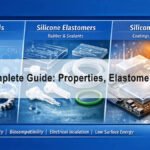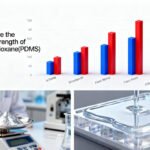Liquid Silicone Resin for Mold Making: Expert Guide
- Blog
- April 18, 2025
- 11:14 am
Liquid silicone resin has become the preferred choice for creating high-precision, durable molds across industries such as prototyping, crafts, and electronics. In this in-depth guide, we’ll explore what makes it unique, how to use it effectively, and how it compares to other materials like UV resin.
Table of Contents
🔍 What Is Liquid Silicone Resin?
Liquid silicone resin is a thermosetting polymer based on siloxane chemistry. When two components (commonly Part A and B) are mixed, it undergoes a curing reaction at room or elevated temperature to form a highly elastic, durable, and heat-resistant rubber.
Its outstanding properties—such as flexibility, thermal stability, low shrinkage, and chemical inertness—make it especially suitable for detailed and complex mold making tasks. Compared to traditional polyurethane or epoxy-based molds, liquid silicone resin for mold making provides better detail replication and longevity.
💡 How to Choose and Cure Resin Molds (vs. UV Resin)


When deciding between liquid silicone resin and UV resin, it’s important to understand the performance requirements of your application:
✅ Choosing Liquid Silicone Resin
Ideal for flexible, reusable molds
Superior for detailed part reproduction and curved surfaces
Excellent for high-temperature or chemically aggressive environments
Options like food grade silicone resin for casting are safe for chocolate, soap, and baking molds
❌ When UV Resin May Not Be Suitable
UV resin is rigid and brittle, unsuitable for demolding complex parts
It requires direct light exposure and cannot cure in deep or shaded sections
Not food-safe or ideal for industrial mold manufacturing
If your project demands elasticity, long-term durability, or food safety, liquid silicone resin for mold making is by far the better choice. For instance, food grade silicone resin for casting is often selected for producing molds used in chocolate, jelly, or soap manufacturing.
🛠 Application Process and Best Practices
Mold Design: Choose a one-piece mold for simple shapes or a two-part mold for complex objects.
Mixing and Degassing: Blend Part A and Part B in the manufacturer’s ratio (e.g., 1:1 or 10:1). Use vacuum degassing to eliminate air bubbles for ultra-smooth finishes.
Pouring and Curing: Slowly pour the mixed silicone over the master model. For deeper molds, a slow, steady pour helps avoid trapping air. Curing can take place at room temperature or under heat, depending on the formulation.
Demolding: After curing, the mold can be removed and used immediately. For technical applications like potting electronics, clear silicone resin for electronic potting ensures both electrical insulation and visual clarity.
⚙️ Real-World Applications
Liquid silicone resin is widely used in:
Prototyping & Industrial Design: To replicate parts quickly and accurately
Electronics: For insulation and encapsulation using clear silicone resin for electronic potting
Food & Cosmetics: With food grade silicone resin for casting, safe molds can be made for soaps, candles, or baked goods
High-Temperature Applications: High temperature silicone resin adhesive is used in molds exposed to extreme heat
In outdoor and marine environments, a UV-resistant silicone resin for marine use helps prevent degradation and yellowing under sunlight.
🧩 Common Issues and Solutions
| Problem | Cause | Solution |
|---|---|---|
| Air bubbles | Fast mixing, no vacuum | Use a vacuum chamber after mixing |
| Sticky mold | Incomplete curing | Ensure accurate mixing ratio and curing time |
| Poor release | Porous model surface | Apply appropriate mold release or sealant |
🌟 Why Choose Silico®?
For professionals seeking reliability, performance, and global compliance, Silico® provides a complete range of high-performance silicone resin systems:
Silico® LSR Series: Easy-flow liquid silicone for detailed mold making and precision components
Silico® Food Grade Resin: FDA-compliant options for food and cosmetic use
Silico® High-Temp Silicone Adhesive: For bonding and molding at up to 250°C
Silico® UV-Resistant Resin: Engineered for outdoor, marine, or automotive conditions
Silico® products are trusted by manufacturers across industries for their consistency, safety, and professional-grade performance.
📌 Final Thoughts
For professionals seeking reliability, performance, and global compliance, Silico® provides a complete range of high-performance silicone resin systems:
Silico® LSR Series: Easy-flow liquid silicone for detailed mold making and precision components
Silico® Food Grade Resin: FDA-compliant options for food and cosmetic use
Silico® High-Temp Silicone Adhesive: For bonding and molding at up to 250°C
Silico® UV-Resistant Resin: Engineered for outdoor, marine, or automotive conditions
Silico® products are trusted by manufacturers across industries for their consistency, safety, and professional-grade performance.
Silico® Silicone Resin Product Recommendation Sheet
| Product Name | Key Features | Recommended Applications | Curing Method |
|---|---|---|---|
| Silico® LSR-1000 | Low-viscosity, fast flow, high elasticity | Precision mold making, jewelry, small crafts | Room temp (RTV) or heat-cure |
| Silico® LSR-2500 | Medium hardness, excellent tear strength | Mold duplication, industrial prototype molds | Heat cure (110–150°C) |
| Silico® FG-500 | Food-grade, non-toxic, odorless | Chocolate, soap, baking molds, cosmetic tools | Room temp (RTV) |
| Silico® EL-900 Clear | Crystal clear, UV-stable, flexible | Potting electronics, optical-grade molds | Room temp or heat-cure |
| Silico® HT-2200 | High temperature resistant up to 250 °C | Metal casting molds, thermal insulation | Heat cure (150–200°C) |
| Silico® MR-UVS | UV-resistant, outdoor-grade durability | Marine molds, automotive trims | Room temp or UV-cure |
| Silico® BOND-A100 | Silicone adhesive resin, excellent substrate bonding | Mold repair, bonding to metals/plastics | Room temp (skin in 10 min) |
✅ Selection Tips
For fine-detail mold replication: Choose Silico® LSR-1000 or LSR-2500.
For food contact molds: Only Silico® FG-500 is FDA-compliant and safe.
For electronic potting with visual clarity: Use Silico® EL-900 Clear.
For high heat exposure applications: Select Silico® HT-2200.
For UV and outdoor resistance: Go with Silico® MR-UVS.
For mold bonding or repair: Use Silico® BOND-A100.
📞 Contact Silico® for SDS, Technical Datasheets & Bulk Orders
Website: silicorex.com
Email: inf@silicorex.com
Popular Recommendations
Get a Catalog & Best Price
- Quick and helpful reply within 24 hours;
- Tailored solutions provided for your project;
- One-stop purchasing service.
TRENDING
Silico® ORGANOSILICON
- Address: Daiyue Industrial Area, Taian, Shandong, China



